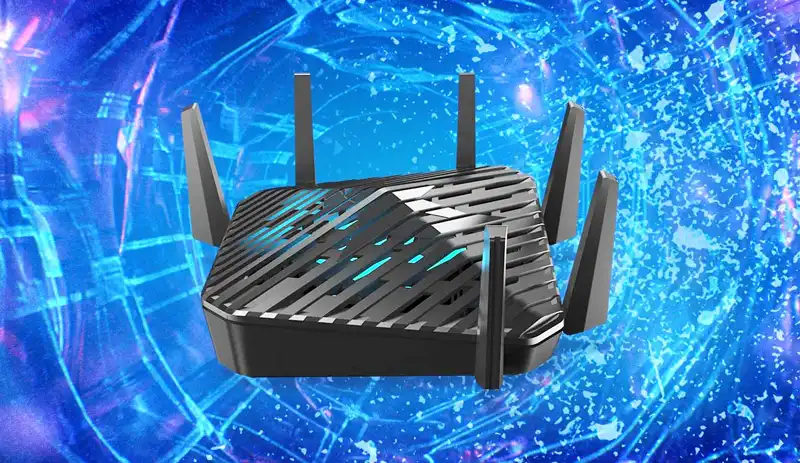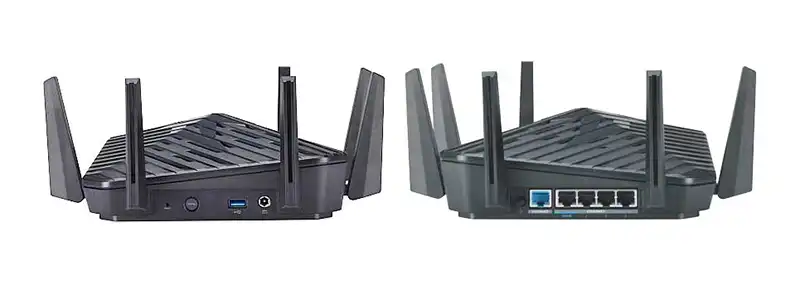You can also be interested in these:
The Acer Predator Connect W6, a router designed for gaming in both its aesthetics and capabilities, will be the focus of this article. As one of the few Wi-Fi 6E routers currently available on the market, it boasts 2×2 2.4GHz, 4×4 5GHz, and 2×2 6GHz bands, as well as 4+1 LAN ports. In addition, its straightforward operating system includes noteworthy features such as the Intel Killer Priorization Engine, VPN, and Trend Micro security.
Exterior design
With a clear gaming-inspired design, the Acer Predator Connect W6 features a broad square shape that measures approximately 27cm on each side and 11cm in height, complemented by six extendable antennas. Its exterior covers, finished in basic matte black plastic, lack visible fingerprints.

Located on the top side is a sizable mesh grille, featuring the Predator logo, that provides passive hardware cooling. However, the Predator logo is not only decorative, as it also features an LED lighting block beneath the grille that displays the device’s status based on the illuminated color. A light blue hue indicates good coverage, while a red hue signals an error or poor coverage.
All sides of the device feature installed antennas, but only the two edges that indicate the front of the device have two antennas positioned on the border, which are foldable and cannot be removed. The remaining two edges on the back of the device will integrate ports and buttons, which we will now examine.
The base of the router is mostly covered by ventilation grilles that allow air to enter the PCB, along with two anchoring points for hanging the router on a wall or piece of furniture. Additionally, four small rubber feet are included if the device is placed on a desk or table. The initial device access credentials will be included on a sticker during the configuration process.
Connection ports
As previously mentioned, the two rear sides of the Acer Predator Connect W6 will feature connection ports.
On the right-hand side, we have:
- Reset button
- WPS button
- USB 3.2 Gen1 Type-A
- Power jack
On the left-hand side, we have:
- Power button
- 1x RJ-45 Ethernet 2.5 Gbps WAN/LAN
- 4x RJ-45 Ethernet 1 Gbps LAN
Regarding wired connectivity, noteworthy aspects include the Internet port, which can also function as a LAN port when configured as an access point.

At the time of review, we did not see any Link Aggregation support in the operating system for the regular ports. However, the LAN port is inscribed with “Gaming,” as it is given the highest priority in the router’s QoS system.
Main features of the Acer Predator Connect W6 router
The Acer Predator Connect W6 features powerful hardware, including a Quad-Core CPU based on ARM A53 cores running at 2GHz, as well as 1Gbps of LPDDR RAM and 4GB of internal eMMC storage. It is unclear why such storage is necessary, as file sharing is expected to be done only through connected USB drives.
Regarding wireless connectivity, this is a Triple Band router that operates simultaneously on 2.4GHz, 5GHz, and 6GHz with a total AX7800 bandwidth. Here is how the bands work:
- Operating under the 802.11ax standard, the 2.4GHz band delivers a maximum of 574 Mbps through a 2×2 connection with 20 and 40MHz channels. The two antennas assigned to 2.4GHz share allocation with 6GHz.
- The 5GHz band provides a bandwidth of 4804 Mbps in 4×4 connections operating on 80MHz channels and supporting 1024-QAM modulation.
- The 6GHz band delivers a maximum bandwidth of 2402 Mbps with a 2×2 capacity on 160MHz channels. The maximum bandwidth is limited if both 2.4GHz and 6GHz are used simultaneously due to their shared antennas.
As with any other Wi-Fi 6/6E router, the Acer Predator Connect W6 is compatible with MU-MIMO, which allows for simultaneous data transmission to multiple clients, OFDMA, which improves the simultaneous connectivity of clients, and BSS Color, which assigns different carrier frequencies (colors) to enable clients to instantly identify their own without analyzing the entire spectrum. The device supports Beamforming and features an operating system function to calibrate the antennas and provide better coverage in the direction of clients.

The 2.4GHz and 5GHz bands support WP2/WP3 security, while the 6GHz band supports WP3, the strongest encryption algorithm currently available. Trend Micro-based security is introduced as a service that requires subscription and payment, which we have not tested. The router also includes additional SSIDs, such as Smart Home, dedicated solely to smart home devices, and SSIDs for guest Wi-Fi.
Configuration and Firmware
While it may not be necessary to configure the router for it to provide Internet and signal on both LAN and WLAN, it is recommended to modify passwords and adjust certain parameters, which we will go over.
To begin, we connect the router and wait for it to fully power on, then access it through the browser using the IP address 192.168.76.1 or through the mobile application. We authenticate with the username “admin” and the password provided on the base label.
Next, we navigate to the quick configuration section to select a convenient setup for connecting the router, WAN connection mode, DNS preferences, and Wi-Fi signal settings. We then recommend checking for firmware updates to ensure the device is up to date from the start.
The first section features a dashboard displaying the status of the connection, Wi-Fi signals, and real-time network traffic, though it is not interactive aside from the bandwidth test below.
One of the standout features of the Acer Predator Connect W6 is the Intel Killer Priorization Engine, a QoS system that intelligently manages network traffic, prioritizing gaming and streaming traffic first through the gaming port and then the rest of the LAN and Wi-Fi. The priority levels and corresponding device types are clearly explained in a table.
The Wi-Fi section enables individual management of the three operational bands in terms of channels and bandwidth, but does not offer a Smart function to unify them under a single SSID. By default, 2.4GHz is configured at 20MHz and 5GHz at 40MHz, so they may not be delivering their maximum capacity. The Smart Home and Guest Wi-Fi modes are introduced, as well as an option to calibrate the Wi-Fi antennas. Acer has not yet implemented a Wi-Fi mesh system for its routers.
In WAN, we can configure the router’s functionality as either a regular router or an access point, which frees up the 2.5Gbps WAN port for use as a LAN port. From this section, we can configure the VPN service in the two supported protocols. The LAN section does not offer any relevant options, as it does not support Link Aggregation or VLAN. It is odd to find the USB section under the System settings, as it only allows for user access configuration.
Final thoughts about the Acer Predator Connect W6 gaming router
While the Acer Predator X5 router we previously reviewed seemed almost unique and very impressive, this Predator Connect W6 seems a bit more generic in terms of both features and functions. It is a good router overall, particularly due to its Wi-Fi 6E capability and the 6GHz band, but it still needs some optimization.
The main points to highlight are the device’s great connectivity capacity with its three frequencies and maximum bandwidth, where 6GHz and 5GHz worked as expected. The operating system is user-friendly and features adaptive QoS signed by Killer, specific for gaming, the ability to configure a VPN server, and plenty of configuration options.
We also appreciated how fast it starts up and its external appearance, which is a minor detail but always appreciated. The wireless coverage is good on the tested frequencies, but not the best in its class, although we do obtain a very good average ping that ensures low latency in streaming data consumption.
As for aspects to improve, the performance on the 2.4GHz band is half of what we could expect from it, and it shares antennas with 6GHz. Why not add two more antennas to separate them? We were somewhat frustrated by our inability to properly test the USB port, as the credentials did not seem to be effective despite configuring them several times.
